


Recoil: According to Benelli, Beretta, Browning, and Remington

A rare glimpse of a young, flying pig. When flying pigs become commonplace, so will useable shotgun recoil claims.
Apparently, gun manufacturers just don't exactly know what recoil is, or how to fairly evaluate it. When it comes to shotguns, I receive more correspondence about recoil than many other topics combined. If you wonder why people are bewildered about kick, you don't have to look very far. Here is a small collection of "who says what" for your entertainment pleasure.
Browning
"The
new Browning Maxus is the softest kicking most reliable shotgun in the
world."

"Morgan, Utah -- Since the introduction of the Auto-5 more than a century ago, Browning has been at the forefront of semi-auto shotgun design. For 2009 Browning continues this long tradition with the introduction of the all new Maxus™ autoloading shotgun. Several innovative technologies combine to make the Maxus deliver up to 18% less felt recoil for greater comfort, 44% less muzzle jump for more accurate follow-up shots, plus 19% faster bolt speed and 24% faster locktime than the nearest competitor."
Benelli

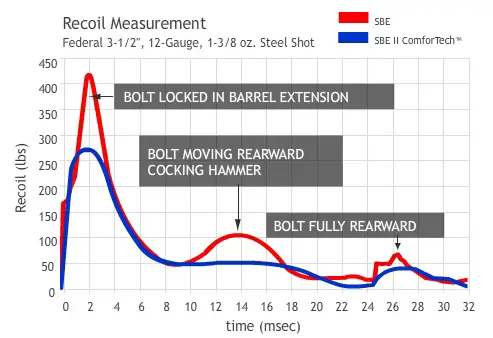
Beretta
As presented for the 391 Xtrema2:

As presented for the A400 Xplor Unico:


Remington
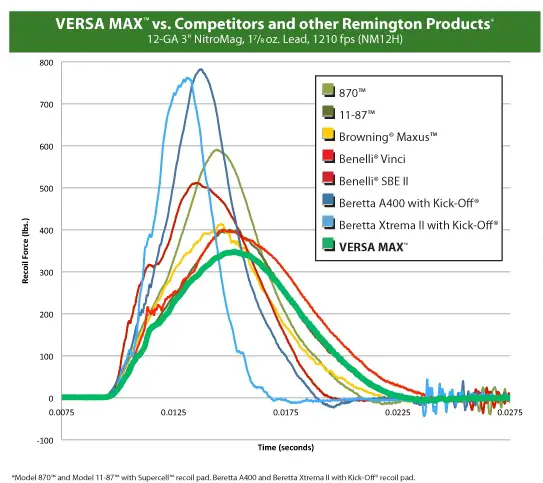
Who do you believe and why? For the answer, or at least "an answer with basis" read on.
PURE OPINION
Well, Houston, we have a problem. Only recently, the "SuperCell" allowed the 870 pump to "beat their semi-autos" . . . according to Remington.
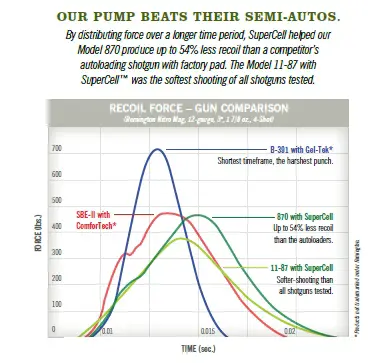
Remington "tests" showed about 450 pounds in force with 1-7/8 oz. 3 inch shell from an 870. Somehow, we now have an incredible contradiction based on the latest Versamax chart. The 870 pump that "beats their semi-autos" no longer does. Even more amazing is that the approximate 450 lbs. of force from the SuperCell 870 has now mysteriously increased to around 590 pounds of force with apparently the same 1-7/8 oz. load-- a whopping 30% increase in recoil for no apparent or stated reason. Like Jimmy Buffett, I know a liar when I hear one. Yet, the 11-87 recoil doesn't seem to have changed much at all in the new graph, except that now it suddenly isn't the softest-recoiling shotgun having a virtually identical profile compared to the substantially lighter Benelli Vinci. For a closer view of the truth, all we have to do is refer to U.S. Patent 6,305,115 of October 23, 2001.
According to Remington, the Beretta Xtrema2 and the Beretta A400 Unico (with Kick-Off) now generate more recoil force than a Beretta 391 with a standard pad. Remington seems more than a bit confused about recoil pads, as the A400 is stated as having a "Kick-Off" recoil pad. The problem is, A400's come with a "Micro-Core" recoil pad, there is no such thing as a Kick-Off pad. The Kick-Off system is an option. It is the "Kick-Off" that Beretta calls the 60% recoil reduction, 70% with the KO3 device that comes automatically with a Beretta A400 Unico. Applying the 60% of the Kick-Off system would bring the A400 down to 310 pounds or so, actually less than the Versamax. I'm not willing to do that arbitrarily, but if Remington wants to stick with the claim of a Versamax having less than half the recoil of a Kick-Off Xtrema2 or a Kick-Off Unico A400, my opinion is that they really shouldn't chart this stuff at the bar. The 1271.88 Newtons of force from the Benelli Super Black Eagle equates to 285.93026 pounds of force, less than anything on the Versamax chart. Confused yet? It's all confusing, particularly when Remington can't decide if their own SuperCell-equipped 870 develops 450 lbs. or 590 lbs. with the same load. No one that has ever shot a Kick-Off system Xtrema or an A400 with 1-7/8 oz. loads would tell you that it kicks more than a standard Beretta 391 Urika 2, an 870, an 11-87, etc., and I mean no one. This is coming from someone that doesn't even like the Kick-Off system feel, extra weight, or extra bulk . . . and has said just that on many occasions. It doesn't mean that the Kick-Off system doesn't work, it does: so does the Hydro-Coil that predates it. Shame on Remington for trying to pass off standard Xtrema2 and standard A400 "testing" as "with Kick-Off." That's either slop, lame, or fraudulent ... call it what you will. I'll just call it bogus info as that's what it is.
I well understand that ad-brags aren't supposed to be informational, though it is a great pity that they make no attempt to be. We have problems in the information department, starting with the equipment and conditions that the tests were conducted with. Without sharing the testing methods and equipment, nothing of substance is shown. Heavy guns of course have less recoil, no news there. I doubt that Remington was trying to show that the far lighter Maxus and Vinci has essentially the same recoil as a Versamax, but that's what the chart says.
If you want to pass along real-world information, a good way to start would be to use shells that are commonly used. A 1-7/8 oz. 1210 fps lead shell is the last thing you'd expect to use out of a waterfowl gun. You wouldn't expect lead anything to be used out of a waterfowl gun, since 1991 lead has been banned for waterfowl use in the U.S. A 1-7/8 oz. lead load is not a commonly used load at all. It is never used in any high volume sense, so the notion of that load being a meaningful one falls rather quickly. If you're breaking clays, dove, or quail hunting, then 1 or 1-1/8 oz. loads would be common. For pheasant, 1-1/4 to 1-3/8 oz. The most common waterfowl load today is 1-1/4 oz. 1450 fps steel, with payloads of 1-3/8 oz. or more about it in any popular sense. If you want meaningful comparisons, you might as well do comparisons with shells that are actually being used-- and used a lot. There is no point in referring to recoil comparisons from shells you won't ever be firing.
If you haven't already guessed it by now, no manufacturer yet has given a comprehensive, accurate comparison of recoil across the most commonly used spectrum of loads. The big winner is "none of the above." I suppose that reliable data and marketing tends to go together like hogs on ice. Hats off, though, to true inventor of the fastest cycling, lightest weight, softest shooting, most reliable automatic shotgun in the world:
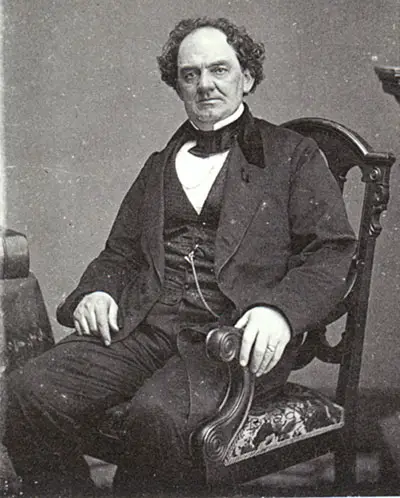
He was born a bit ahead of his time, that's all. Though no one likes to hear it, the fundamentals of recoil hasn't changed. Actual recoil is a relationship of gun weight to the mass of the payload and the velocity of payload. Perhaps a boring event, but that's what it is. As to what a shotgun action can do to change the way that recoil event feels, there are very few options. A fixed breech can do nothing of substance to change the way recoil feels. That has done nothing to stop the enjoyment of double guns over the years as long as what we shoot is appropriate to gun weight and the gun fits properly. Nor has it done a thing to stop the great success of the most popular type of shotgun in the United States, the slide-action.
Scant few actions can do much to address the recoil event is any substantial way. One was the Browning Recoiless. The gas-operated shotgun isn't a new idea at this stage of the game and actual recoil remains the same due to zero sum at the end of the event. Whether it is a B2000, a 300 series Beretta, an 1100, a Browning Gold or any number of gas actions, the recoil event is changed with a gas piston or pistons, action bar, and breechblock moving in the opposite direction of the primary recoil pulse generating reverse recoil. At the end of the movement, zero sum prevails and actual recoil is the same. It is a well-settled matter.
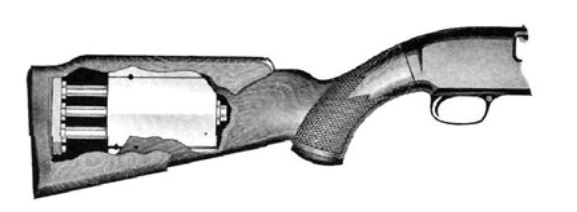
Beyond that, we aren't talking about the shotgun itself, we are referring to stock and recoil pad for the most part. There was the Cycolac Hydro-Coil stock, the stock invented by Ralph O. Hoge. The patented Hydro-Coil (above) was featured in Sports Illustrated (Sept. 9, 1963), claimed to reduce recoil by as much as 85%, and became a standard option available from Olin-Winchester. Like the far more recent Beretta Kick-Off system, actual recoil was not reduced and there was more gun movement as the shock absorber array collapsed. It works though, as far as increasing shooter comfort as does the Kick-Off system. Aftermarket stocks today include the Precision Fit Stock and the GraCoil compression butt plate. The negatives are aesthetics, weight, and bulk. Sometimes, we say we want some things, but we really don't want them nearly as badly as we originally said we did.
When it comes to manufacturer's claims, the old Maxim of "He who asserts must prove" applies. As far marketing charts in general, they do create a bit of commotion-- that's why they exist. The real answer is what we have always known, shooting the loads we choose to shoot in the volume we choose to shoot them, under the conditions we see, the manner of dress we choose, and under the applications we choose to use them for. That doesn't work well in marketing chart-making, it seems.
Copyright 2010 by Randy Wakeman. All Rights Reserved.

Custom Search



